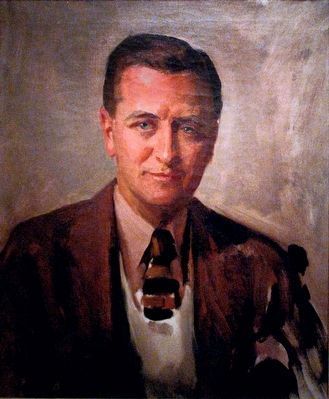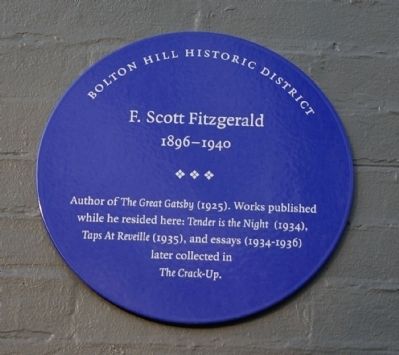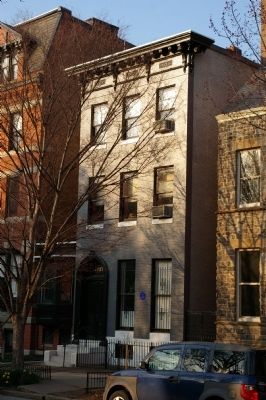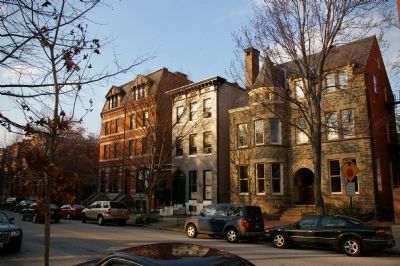Bolton Hill in Baltimore, Maryland — The American Northeast (Mid-Atlantic)
F. Scott Fitzgerald
1896-1940
Erected by Bolton Hill Historic District.
Topics and series. This historical marker is listed in this topic list: Arts, Letters, Music. In addition, it is included in the Maryland, Bolton Hill Historic District series list.
Location. 39° 18.383′ N, 76° 37.396′ W. Marker is in Baltimore, Maryland. It is in Bolton Hill. Marker is on Park Avenue, on the right when traveling north. Touch for map. Marker is at or near this postal address: 1307 Park Avenue, Baltimore MD 21217, United States of America. Touch for directions.
Other nearby markers. At least 8 other markers are within walking distance of this marker. Edith Hamilton / Alice Hamilton, M.D. (within shouting distance of this marker); Mergenthaler House (within shouting distance of this marker); William Edwards Stevenson (within shouting distance of this marker); Ernest Stebbins, M.D. (within shouting distance of this marker); Family and Children’s Services of Central Maryland (within shouting distance of this marker); Florence Rena Sabin, M.D. (within shouting distance of this marker); Colonel Charles Marshall (about 300 feet away, measured in a direct line); Hugh Lennox Bond (about 400 feet away). Touch for a list and map of all markers in Baltimore.
Also see . . . Biography of Fitzgerald. (Submitted on October 17, 2008, by Christopher Busta-Peck of Shaker Heights, Ohio.)

Photographed By Allen C. Browne, November 2, 2011
4. F. Scott Fitzgerald
This 1935 portrait of F. Scott Fitzgerald by David Silverette hangs in the National Portrait Gallery in Washington, DC.
“It was F. Scott Fitzgerald who named the selfindulgent 1920s the Jazz Age, and his best-selling novel This Side of Paradise became one of the decade's first literary landmarks. But his most enduring achievement was The Great Gatsby (1925), which, in meticulously crafted prose, wove a modern morality tale set against a backdrop of luxury. Fitzgerald and his talented wife, Zelda, experienced — in New York, Paris, and Hollywood some of the glamorous life he evoked. But struggling with financial disappointments, alcoholism, and Zelda's mental illness, Fitzgerald also probed the destructive underside of the era's bright illusions. When he met artist David Silvette in 1935, Fitzgerald was suffering from an emotional breakdown. He agreed to pose, however, and considered this a swell portrait. His career as chronicler of the dreams and disappointments of contemporary life was cut short by his death five years later.” — National Portrait Gallery
“It was F. Scott Fitzgerald who named the selfindulgent 1920s the Jazz Age, and his best-selling novel This Side of Paradise became one of the decade's first literary landmarks. But his most enduring achievement was The Great Gatsby (1925), which, in meticulously crafted prose, wove a modern morality tale set against a backdrop of luxury. Fitzgerald and his talented wife, Zelda, experienced — in New York, Paris, and Hollywood some of the glamorous life he evoked. But struggling with financial disappointments, alcoholism, and Zelda's mental illness, Fitzgerald also probed the destructive underside of the era's bright illusions. When he met artist David Silvette in 1935, Fitzgerald was suffering from an emotional breakdown. He agreed to pose, however, and considered this a swell portrait. His career as chronicler of the dreams and disappointments of contemporary life was cut short by his death five years later.” — National Portrait Gallery
Credits. This page was last revised on April 17, 2020. It was originally submitted on March 22, 2008, by Christopher Busta-Peck of Shaker Heights, Ohio. This page has been viewed 2,400 times since then and 65 times this year. Photos: 1, 2, 3. submitted on March 22, 2008, by Christopher Busta-Peck of Shaker Heights, Ohio. 4. submitted on October 12, 2015, by Allen C. Browne of Silver Spring, Maryland.


